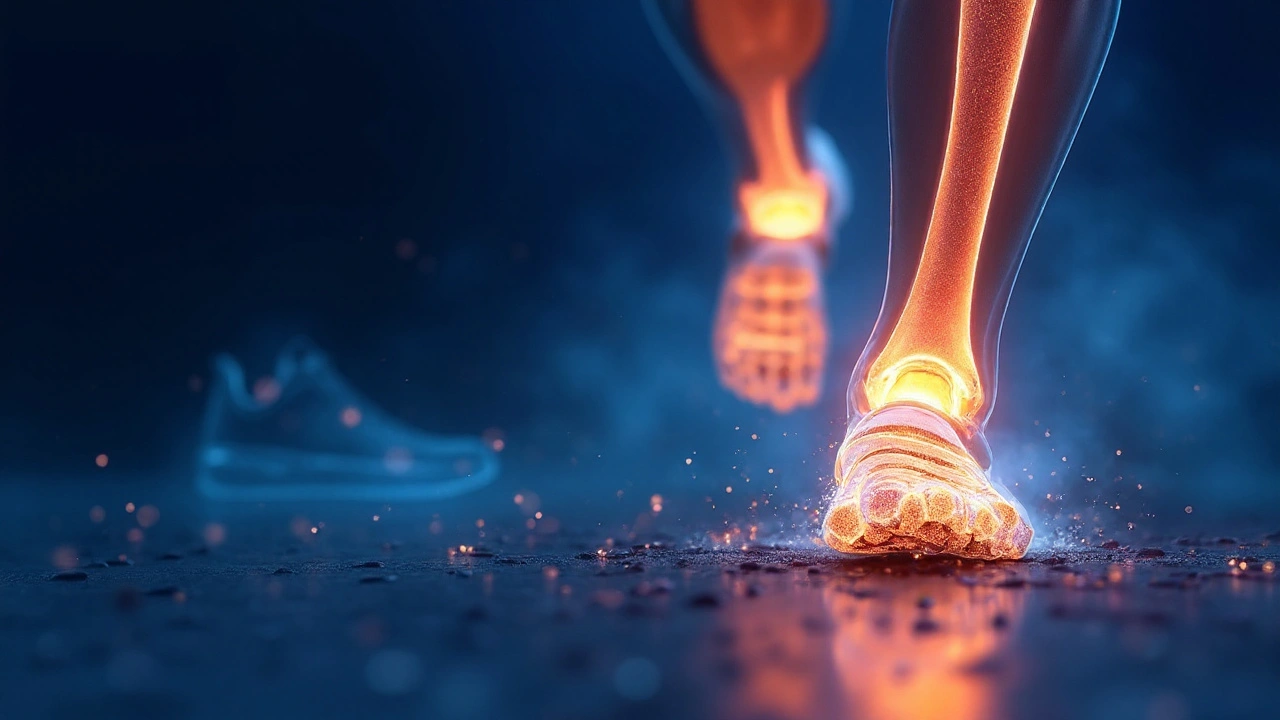TL;DR
- Alendronate isn’t a performance enhancer; it doesn’t boost VO₂max, power, or speed. It’s a bone drug for specific medical situations.
- It can increase bone mineral density and lower fracture risk in people with osteoporosis. In healthy athletes, prevention of stress fractures is unproven.
- Not on the 2025 WADA Prohibited List. Always check your sport’s rules and keep records.
- Side effects and rare risks (jaw issues, atypical femur fractures) mean it’s not a casual “just in case” pill.
- Best candidates: athletes with diagnosed low bone density or recurrent bone stress injuries linked to RED‑S/menstrual dysfunction or low hormones, after nutrition and training fixes are underway.
What alendronate does (and doesn’t) do in sport
If you’re asking, “Is alendronate for athletes a performance enhancer?”, the short answer is no. Alendronate is a bisphosphonate-prescription medicine that slows bone resorption. It’s built to treat osteoporosis, not to shave seconds off a 5K. In people with fragile bones, it improves bone mineral density (BMD) and reduces fracture risk. That can indirectly help an athlete by cutting time lost to fractures. But it won’t move your lactate threshold or increase sprint power.
Mechanism in one breath: alendronate binds to bone surfaces and gets taken up by osteoclasts (the cells that break down bone). It slows turnover so that bone formation can catch up, tipping the balance toward denser, stronger bone-over months, not weeks.
What the evidence actually supports:
- In postmenopausal women and older adults with osteoporosis, large randomized trials (e.g., the Fracture Intervention Trial series published in the New England Journal of Medicine) show increased BMD and fewer vertebral and hip fractures over 3 years.
- In young, healthy athletes, data are sparse. Small, mixed-population studies and military training cohorts have not shown a consistent reduction in stress fractures with bisphosphonates. The quality of evidence is low for this specific use.
- There’s no compelling research showing improved running economy, VO₂max, peak power, time trial results, or jump metrics with alendronate.
So why does it keep coming up in sport? Because bone stress injuries can wreck a season. If you’ve had repeated tibial or metatarsal stress injuries, or your DXA scan turns up low BMD, you start hunting for tools. Alendronate can be one tool in a narrow set of cases-after you’ve fixed fueling, hormones, vitamin D, calcium, and training load.
| Outcome | Population | Evidence quality | Expected effect | Typical timeline |
|---|---|---|---|---|
| Bone mineral density (BMD) | Osteoporosis (postmenopausal/older adults) | High (multiple RCTs) | +5-8% spine BMD over 2-3 years | Measurable by 6-12 months; larger by 24-36 months |
| Fragility fracture risk | Osteoporosis | High | Reduces vertebral and hip fractures | Benefits accrue over 1-3 years |
| Stress fracture prevention | Young, healthy athletes | Low | Unclear/likely minimal without low BMD or hormonal issues | Unknown; no reliable effect size |
| Performance (VO₂max, power, speed) | Athletes | Low | No direct improvement | None |
| Stress fracture healing speed | Athletes with acute injury | Low | No proven acceleration; theoretical pros/cons | Not reliable |
Key takeaway: useful for bone health in the right patient; not a shortcut to faster splits.
Who should consider it: scenarios, evidence, and a practical decision guide
Think of alendronate as a prescription safety net for bones that are already in trouble-not as a prophylactic for every high-mileage runner or powerlifter.
Strong candidates (after a proper workup):
- Athletes with DXA-confirmed osteoporosis (T-score ≤ −2.5) or osteopenia with a fragility fracture.
- Recurrent bone stress injuries (two or more in 2 years) plus low BMD or clear drivers like low energy availability/RED‑S or low sex hormones.
- Masters athletes (especially postmenopausal women or men over 50) who meet guideline criteria for pharmacologic osteoporosis treatment.
Borderline candidates:
- Athletes with osteopenia (T-score between −1.0 and −2.5) but no fractures. Here, nutrition, menstrual recovery or testosterone normalisation, resistance training, and load management usually come first. Medication is a judgment call.
- High-risk tactical or endurance settings with repeated bone stress injuries despite ideal training and nutrition-still case-by-case.
Poor candidates:
- Healthy young athletes with normal BMD and no fracture history. Risks outweigh hypothetical benefits.
- Athletes planning pregnancy soon (bisphosphonates incorporate into bone for years; most experts avoid them in people trying to conceive). The Endocrine Society and IOC consensus statements on RED‑S advise prioritising energy availability and hormonal recovery in premenopausal athletes.
What a sensible workup looks like before anyone talks scripts:
- DXA scan (lumbar spine, hip; consider forearm if needed). For athletes, also ask for Trabecular Bone Score if available.
- Bloods: vitamin D (25‑OH), calcium, phosphate, renal function, thyroid (TSH), celiac screen if indicated, sex hormones (estradiol for women, testosterone for men), and markers of low energy availability if your clinician uses them.
- Training review: sudden load spikes, monotony index, surface changes, footwear, calcium/vit D intake, protein intake, and menstrual history.
- Nutrition check: ensure enough energy, calcium (~1000-1300 mg/day from food), and vitamin D (dose individualised to reach adequate blood levels; many aim for 50-75 nmol/L or as locally recommended).
Decision guide you can actually use:
- If you have osteoporosis by DXA or a fragility fracture → discuss alendronate or another first‑line osteoporosis therapy with your doctor.
- If you’ve had two or more bone stress injuries and your DXA shows low BMD or you have RED‑S → fix fueling and hormones first. If injuries persist, consider medication as a backup plan.
- If your BMD is normal and your injuries are load‑related → adjust training, build strength, and address technique and surfaces. No medication needed.
What about athletes trying to “harden bones” proactively? Nice idea in theory; in practice, it misses the point. Bones adapt to smart load, protein, calcium, vitamin D, and hormones. If you blunten bone turnover without need, you can interfere with micro‑damage repair and rack up long‑term risks with little upside.
How long until you see benefit? Bone is slow. Even in osteoporosis, BMD changes show up after 6-12 months and keep improving for 2-3 years. That means any reduction in fracture risk is a medium‑term play, not a race‑day fix.
Evidence notes and credible sources:
- Fracture Intervention Trial (NEJM) and follow‑ups: alendronate improves BMD and reduces fractures in osteoporotic populations.
- IOC RED‑S consensus statements (2018, 2023 update): prioritise restoring energy availability and menstrual function; medications are secondary.
- Endocrine Society osteoporosis guidelines: alendronate is first‑line for many adults with osteoporosis; avoid in pregnancy/plan‑to‑conceive.
- American Society for Bone and Mineral Research task force: prolonged use associated with rare atypical femoral fractures-consider drug holidays in long‑term therapy.

Safety, side effects, anti‑doping, and correct use
Big picture risks you should know:
- Common: reflux, esophageal irritation, stomach upset, musculoskeletal aches.
- Less common: low calcium if vitamin D or calcium intake is poor, eye inflammation.
- Rare but important: osteonecrosis of the jaw (ONJ; risk higher with invasive dental work and in cancer patients on high‑dose IV bisphosphonates) and atypical femoral fractures with long‑term use.
Two athlete‑specific wrinkles:
- Dental work: if you need major dental surgery, talk to your dentist and prescriber about timing. Good oral hygiene and routine dental care matter.
- Bone remodeling and adaptation: by slowing turnover, bisphosphonates may slightly change how bone adapts to training. In people who need the drug, the benefit outweighs the theoretical downside; in people who don’t, it’s a reason not to dabble.
Anti‑doping status (2025):
- Alendronate and other bisphosphonates are not on the 2025 WADA Prohibited List for human athletes. Always recheck the current list and your national agency (in New Zealand, Drug Free Sport NZ) before starting any prescription.
- Keep records: prescription, diagnosis, DXA results. You usually won’t need a TUE for alendronate, but documentation protects you.
How it’s typically taken (don’t self‑prescribe):
- Common regimen: 70 mg once weekly or 10 mg daily. Weekly dosing is most used for convenience.
- Take first thing in the morning with a full glass of plain water, on an empty stomach.
- Stay upright (sitting or standing) for at least 30 minutes after. Don’t eat, drink (other than water), or take other meds during that window.
- Avoid taking it with calcium, iron, magnesium, coffee, or juice-they block absorption. Space those by a few hours.
- Contraindications include esophageal disorders that delay emptying, inability to remain upright for 30 minutes, severe kidney impairment, and hypocalcemia until corrected. Your prescriber will screen for these.
Monitoring and duration:
- Recheck vitamin D and calcium intake after starting.
- DXA every 1-2 years to monitor response and reconsider need.
- Duration is individual. Many guidelines suggest reassessing after 3-5 years; some people take a “drug holiday” if risk becomes low. Long‑term plans should be set with a bone specialist.
Local notes for New Zealand readers:
- Alendronate is prescription‑only and listed on the Pharmaceutical Schedule (brand names vary). Funding criteria usually require osteoporosis or fracture risk-ask your GP or sports physician.
- Medsafe’s data sheets outline dosing, contraindications, and adverse effects used by NZ prescribers.
- Drug Free Sport NZ follows WADA; check the current list before competitions.
Alternatives, checklists, and FAQ
If your goal is fewer bone stress injuries and sturdier bones, start with the basics that move the needle. Medication comes after.
High‑impact basics
- Energy availability: if you’re under‑fuelled, your body turns down bone formation. Aim to eat enough for training and recovery. Female athletes with missed periods need this addressed first.
- Protein: target roughly 1.6-2.2 g/kg/day, spread across meals; include leucine‑rich foods post‑training.
- Calcium and vitamin D: food first for calcium (dairy, calcium‑set tofu, fortified plant milks, leafy greens). Vitamin D depends on sun and blood levels; your clinician can personalise dosing.
- Strength training: 2-3 sessions/week with progressive load, especially compound lifts and plyometrics as tolerated. Bones love intensity more than endless volume.
- Load management: avoid sudden jumps in mileage or plyos; vary surfaces; rotate shoes; periodise intelligently.
- Hormones: restore regular cycles in women and normal testosterone in men if low; this is a cornerstone of bone recovery.
When non‑drug options aren’t enough, what else could be considered?
- For postmenopausal athletes with symptoms and low BMD: menopausal hormone therapy may be appropriate under medical guidance.
- For severe or recurrent bone stress injuries with very low BMD: an anabolic agent like teriparatide may be considered by a bone specialist. Data in athletes are limited; it’s reserved for tough cases.
- Other bisphosphonates (risedronate, ibandronate, zoledronic acid) exist, but the same performance caveats apply.
Simple bone‑risk checklist for athletes
- Two or more bone stress injuries in the past 24 months?
- DXA scan ever show osteopenia/osteoporosis?
- History of missed periods or low testosterone?
- Low BMI or rapid weight loss; persistent fatigue; frequent colds?
- Vitamin D deficiency in the last year?
- Big, sudden training load increases without recovery?
If you tick several boxes, book with a sports doctor or endocrinologist. A medication talk might be on the table-but only after the basics are fixed.
Mini‑FAQ
Will alendronate help a stress fracture heal faster? Not reliably. Some theories say reduced turnover could help early callus stability; others worry it could delay remodeling. Clinical trials don’t show a consistent speed‑up in healing for athletes. Standard care-load reduction, nutrition, and gradual return-still rules.
Can it make bones “too hard” and brittle? Long‑term oversuppression of turnover is linked to rare atypical femur fractures. That’s why duration and periodic reassessment matter, and why drug holidays are considered in long‑term therapy.
Is it legal in sport? Yes, alendronate isn’t banned by WADA in 2025. Keep documentation and check your sport’s rules.
Do I need a TUE? Usually no for alendronate, but keep your prescription and clinical justification handy in case of questions.
What about younger athletes in their teens and 20s? Be cautious. Because the drug sits in bone for years and pregnancy plans may change, most experts avoid bisphosphonates unless there’s a serious, documented bone problem and specialist oversight.
Any daily‑life tips to reduce side effects? Take it with plain water on an empty stomach and stay upright for 30+ minutes. Don’t chase it with coffee or a smoothie. Keep up calcium from food; separate supplements by a few hours.
Should I worry about dental work? Tell your dentist you’re on a bisphosphonate. Routine care is fine; time invasive procedures thoughtfully with your prescriber.
How soon could it “help my performance” indirectly? If it prevents fractures you might avoid time off, but that benefit shows up only over months to years. There’s no short‑term boost.
Next steps: practical pathways by athlete type
- Endurance runner with two tibial stress injuries: book a DXA; check vitamin D and iron; increase energy intake; add two heavy lift days; consider gait review. If DXA shows osteopenia and RED‑S signs, stabilise nutrition first; discuss medication only if injuries keep repeating.
- Postmenopausal triathlete with a wrist fragility fracture: you likely meet criteria for treatment. Talk options (alendronate vs. others), start strength training, ensure calcium/vitamin D, and build a return‑to‑run plan.
- Male cyclist with low testosterone and sacral stress fracture: address hormones and energy availability urgently; add impact training when safe; medication may be considered if BMD is low.
- Collegiate jumper with normal BMD but metatarsal stress reaction after a load spike: fix training progression, footwear, and nutrition. No medication.
Quick troubleshooting
- Reflux after dosing? Confirm you’re taking it with plain water, upright, and waiting 30 minutes before food. If symptoms persist, tell your prescriber-there are alternatives.
- New thigh or groin ache on long walks after years on therapy? Flag it early-rare atypical femur fractures can start with nagging pain.
- Missed a weekly dose? Don’t double up the next day. Follow your product sheet or ask your pharmacist.
Bottom line: alendronate can protect bones in athletes who meet medical criteria, but it won’t make you faster. If your goal is performance, build it on energy availability, smart training, strength, and sleep. If your bones need pharmacologic backup, do it with a clear diagnosis, a plan, and a clinician who knows sport.



so like... if your bones are weak, you just take a pill and boom you're invincible? 😏 we're all just meat sacks trying to outlast entropy, but somehow we think chemistry can fix what lifestyle broke? i mean, sure, take the pill if you're dying of brittle bones, but don't pretend it's a cheat code for faster splits. we're not machines, we're messy, hormonal, sleep-deprived creatures who think kale smoothies make us holy. 🤡
alendronate won't make you faster but it might keep you from missing 6 months of training because your tibia turned into chalk
that's not a magic bullet it's a backup plan
and honestly if you're even asking this question you probably need to eat more carbs and sleep more
but hey at least you're thinking about it 🙌
if you've had two stress fractures and your period's gone for a year no pill is going to fix that
you need food sleep and someone to hold your hand while you rebuild
alendronate is a bandaid on a broken leg
but if you've done all the hard work and your bones still won't hold up
then yeah maybe it's worth talking to your doc
no shame in needing help
just don't skip the foundation
look i read the whole thing and you're still overcomplicating this
if you're a healthy 25yo runner with normal BMD and no history of fractures you're not taking alendronate
period
end of story
you're not osteoporotic you're just lazy with recovery and scared of strength training
go lift heavy stop running on concrete and eat a protein bar after workouts
no drug needed
and stop wasting your doctor's time with this nonsense
what does it mean to be a strong bone
is it density
or is it adaptability
alendronate makes bone denser but does it make it more alive
or does it just freeze the process like a photograph of movement
we optimize for outcomes but forget that bones are living systems that respond to rhythm stress and care
maybe the real question isn't whether to take the pill
but whether we've stopped listening to what our bodies are trying to tell us
in india we used to say bones heal with milk and rest
now we have scans and pills
but the truth is still the same
eat enough sleep enough move right
if you still break
then maybe medicine helps
but don't skip the basics
they're not outdated
they're essential
alendronate is a pharma Trojan horse disguised as a bone protector
they're not trying to fix osteoporosis
they're trying to normalize lifelong pharmaceutical dependency
look at the long-term risks - atypical femur fractures are being downplayed because the profit margin is too good
and don't get me started on the dental industry being quietly complicit
you think this is medicine
it's a revenue stream wrapped in clinical jargon
and you're the customer
your bones are just the product
bro i took alendronate after my 3rd stress fracture and honestly it was a game changer 🤯
but only after i fixed my diet stopped running on asphalt and started doing squats
also i cried in my doctor's office because i realized i'd been treating my body like a disposable battery
so yeah the pill helped
but it was the wake-up call that mattered
also i use emojis now because i'm healed emotionally too 😭💪